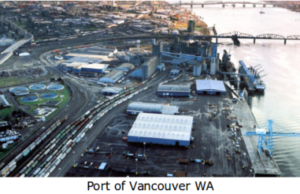The Thin Green Line – an enigmatic, yet intuitively charged, descriptor of the ecological organizations in the Pacific Northwest that are engaged in near heroic struggles against fossil fuels. The involved activists consist of environmental groups, Native tribes, think tanks, community empowerment groups, public interest law firms, and others. They aren’t necessarily working as a unit, though their causes overlap, and they often collaborate on large issues. But collectively they are The Thin Green Line, and have a cumulative impact blocking tar sands oil, fracked shale oil, natural gas, and coal from reaching export terminals on the Pacific coast. Two of the key players are the Sightline Institute that ties issues and groups together with research and news, and the Columbia Riverkeeper that acts on many levels of river protection, legislative efforts, and regulatory challenges. The Sightline Institute maintains the website of The Thin Green Line.

As their website says “The Pacific Northwest stands squarely between the most voracious energy markets in the world and huge fossil fuel deposits in the interior of North America — Powder River Basin coal, Bakken shale oil, Alberta tar sands, and remote natural gas fields”. The region itself doesn’t have much in the way of energy deposits for export, but it can act as gatekeeper. The ports of the states of Oregon and Washington and the province of British Columbia are absolutely essential for Big Energy to sell their carbon-intense fuels to Asian markets. Climate and ecological activists recognize these ports to be strategic choke points. By controlling the ports, they can seriously bottle up the energy. It’s a Thin Green Line they have drawn in the sand.
Success comes from persistence more than anything. Community organizers have a saying “Developers always come back”. It’s like a game of whack-a-mole. Corporations are all about profit, and their money must not be idle, but invested in active pursuits. So if they are thwarted at one turn, they always seek another approach – a different pipeline route, a more compliant town, a stronger legal argument. They must be beat back repeatedly. Some of these battles have taken 12 years or more of filings and hearings and court appearances. Victory under such circumstances takes persistence that comes only from passion, such as love of a river, or the beauty of community.

A couple recent successes of the Thin Green Line have been Fracked Gas-to-Methanol Refinery Permit Ruled Invalid, and Portland’s Landmark Fossil Fuel Policy Ruled Constitutional. Big or small, each victory adds up. One of the more notable victories was the Failure for Giant Tesoro Oil Train Terminal. Tesoro Oil had proposed to build North America’s biggest oil train depot within blast radius of downtown Vancouver WA on the Columbia River. The Tesoro Savage terminal was the last remaining undecided project of at least a dozen export proposals. Prior to this, other proposals were defeated by community opposition – Clatskanie, Longview, Grays Harbor, Tacoma, Anacortes, and Whatcom County. Tesoro’s case was fought for years, recently through a series of hearings before the Washington Energy Facility Site Evaluation Council (EFSEC). On 28 November 2017, EFSEC unanimously recommended denial of the Tesoro Savage oil terminal. Governor Jay Inslee had then to make the final decision, and he denied the permit on 29 January 2018 – Failure for Giant Tesoro Oil Train Terminal. One might say that The Thin Green Line tied the knot on this one. But they always come back. Here’s one that you may want to help out with – Fight Fracked Gas! Protect the Columbia!.


Recent Comments